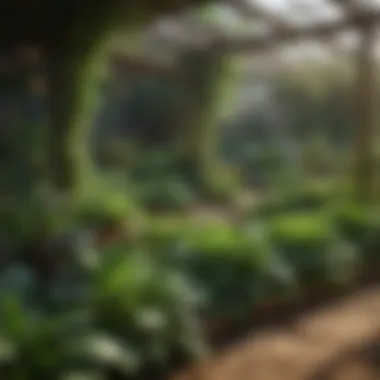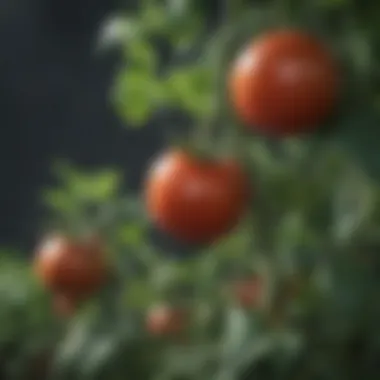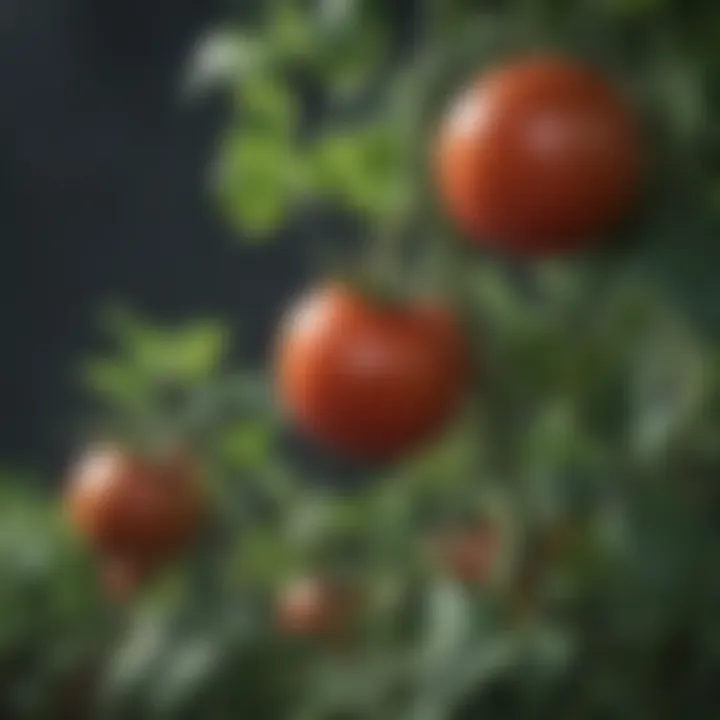Easy Veggie Garden Plants for Every Gardener


Intro
Creating a vegetable garden is both a fulfilling and practical endeavor. For some, it is a hobby; for others, it is a way to ensure fresh produce is available right at home. Regardless of motivation, understanding the right plants to cultivate is vital. This article will serve to guide homeowners and gardening enthusiasts through accessible vegetable garden plants appropriate for all skill levels.
Each plant comes with its individual requirements and benefits. We'll dissect these characteristics and provide methods for cultivation. Additionally, we'll touch on soil preparation, fertilization, and seasonal considerations critical to the success of a vegetable garden. Our exploration aims to make gardening an enriching part of life, enhancing overall well-being and contributing to a sustainable lifestyle.
By focusing on ease of cultivation and productivity, this comprehensive guide is designed to help you grasp the essentials of starting or improving your veggie garden, paving the way for vibrant and healthy growth.
Plant Selection Criteria
In any successful garden, choosing the right plants is essential. Here, we consider several factors when selecting easy veggie plants:
- Climatic Suitability: Understand your local climate to select plants that thrive in your conditions.
- Soil Requirements: Different plants have varying needs regarding soil composition and pH.
- Growth Rate: Beginners may prefer plants that mature quickly, providing quicker rewards for their efforts.
- Nutritional Value: Select plants that provide health benefits and can contribute to a balanced diet.
These criteria form the foundation for aligning plant choices with gardener capabilities and environmental factors.
Recommended Easy Veggie Plants
- Radishes
Radishes are renowned for their fast growth; they typically reach maturity in just three to four weeks. They thrive in various soil types and prefer cooler weather. - Lettuce
Easy to grow, lettuce also has quick turnover, allowing for multiple harvests in a season. It does best in well-drained soil and partial shade. - Zucchini
This summer squash is prolific. One or two plants can yield a substantial harvest, provided they are given ample sun and nutrients. - Green Beans
Green beans are simple to grow and can produce a continuous harvest if picked regularly. They require minimal care once established. - Tomatoes
While slightly more demanding than the previous entries, tomatoes can yield significant rewards. Choose determinate varieties for smaller spaces.
Soil Preparation
Soil can dramatically affect plant growth and health. Therefore, initial preparation is key. Consider the following steps:
- Testing Soil pH: A simple soil test can help determine your soil's nutrient availability and pH level.
- Amending Soil: Based on test results, you might need to add organic matter like compost or peat moss to improve soil structure.
- Tilling: Breaking up soil can aid in drainage and aeration.
- Mulching: Apply a layer of mulch to retain moisture and suppress weeds.
Proper soil preparation lays the groundwork for healthy and productive plants.
Fertilization Strategies
Once the soil is prepared, attention must turn to fertilization. This step ensures plants receive essential nutrients:
- Balanced Fertilizers: Use a fertilizer with equal parts nitrogen, phosphorus, and potassium for general use.
- Organic Options: Compost or well-rotted manure can enhance soil fertility without chemical additives.
- Regular Applications: Follow a schedule of fertilization, especially during growth phases, to support optimal development.
Seasonality Considerations
Understanding planting times is crucial in vegetable gardening. Each plant has its preferred planting season:
- Cool-season crops like radishes and lettuce are best planted in early spring or late summer.
- Warm-season crops like tomatoes and zucchini should be planted after the last frost.
Knowledge of seasonality maximizes growth potential and yield.
"A successful garden is not just about planting seeds; it involves an understanding of nature and the cultivation of patience."
This comprehensive guide will not only facilitate a productive veggie garden but will also encourage a connection to the environment. Each section addresses necessary steps along the path to a thriving garden, ensuring readers feel equipped to take on this rewarding challenge.
An Foreword to Easy Vegetable Gardening
Easy vegetable gardening can be an incredibly rewarding endeavor. It serves as a form of self-expression, providing creativity that reflects personal tastes and preferences. In a world often busy and disconnected from nature, growing your own vegetables means taking control of one’s food sources. This article will serve as a guide to help you understand how to begin the journey of easy veggie gardening.
Home gardening offers several benefits, such as saving money and ensuring food freshness. It enhances physical health through the consumption of produce cultivated in a pollution-free environment. Moreover, gardening can act as therapeutic escapism, allowing individuals to de-stress while nurturing living plants.
This guide aims to simplify the gardening process for both beginners and seasoned gardeners. Understanding what qualifies as 'easy' will be pivotal in selecting the right plants that can provide quick and satisfying results.
Understanding the Importance of Home Gardening
Home gardening presents unique advantages beyond mere plant cultivation. It introduces sustainability by reducing reliance on commercial produce. This not only lower transportation emissions but also promotes biodiversity within your local area.
Gardening can also increase self-sufficiency. By growing vegetables, you can ensure you have access to fresh and organic produce. Moreover, home gardening encourages physical activity. Regular engagement in maintaining a garden can enhance fitness and overall health.
Get involved in home gardening to also improve mental well-being. Spending time outdoors has been shown to decrease anxiety and depression. Even small-scale gardens can provide solace, allowing for moments of reflection and tranquility.
Defining 'Easy' in the Context of Vegetable Plants
The term 'easy' signifies more than a lack of complexities; it embodies the characteristics of vegetable plants that adapt well to a new gardener's skills. Easy plants generally have faster growth cycles and require less maintenance compared to their more demanding counterparts.
Key elements to consider when defining easy vegetables include:
- Growth Rate: Quick-growing plants such as lettuce or radishes can provide immediate satisfaction, allowing beginners to see results within weeks.
- Space Requirement: Many easy-to-grow vegetables don't need vast areas. Container gardening or raised beds can accommodate such plants, making them suitable for urban settings.
- Climate Adaptability: Selecting varieties that thrive in local conditions ensures better yields. Understanding temperate zones and choosing the right time to plant is crucial for success.
With these points in mind, one can approach the adventure of vegetable gardening with significant confidence. The following sections will delve into specific plants and methods that align with the above considerations.
Selecting Easy Vegetable Plants
Selecting easy vegetable plants is a significant step for both novice and experienced gardeners. Understanding which plants are most suited for your gardening situation can lead to a more successful harvest and an enjoyable experience. The right choices will alleviate the intimidation that often accompanies gardening.
Criteria for Choosing Easy Veggies
Choosing the right vegetables involves a few essential criteria that focus on the specific needs of both the plants and the gardener.
Growth Rate
Growth rate is a crucial factor when selecting vegetables. Fast-growing plants like lettuce or radishes can provide the satisfaction of quick results. They mature in a matter of weeks, making them ideal for beginners who may want to see progress promptly. Such rapid growth can keep enthusiasm high and motivation strong. However, one disadvantage might be that quick growth can sometimes lead to overlooked pests or other issues if the gardener isn't attentive.
Space Requirement


Space requirement plays a vital role in selecting vegetable plants. Understanding how much room each plant needs can optimize the garden layout. For instance, squash and tomatoes typically require more space, while herbs or compact vegetables can thrive in limited areas. Choosing plants that match your available space ensures that each plant receives adequate light and air, which promotes healthy development. However, if too many plants are crammed into a small space, they may compete for resources and fare poorly.
Climate Adaptability
Climate adaptability refers to how well a vegetable plant can thrive in its growing conditions. Selecting plants that match your local climate can streamline the gardening process. For example, some plants can tolerate cooler temperatures, while others flourish in heat. Choosing adaptable vegetables allows for successful growth throughout the seasons. A key advantage lies in reduced maintenance and a lower likelihood of plant failure. However, lesser-known crops may require different care than popular options, which can be a learning curve for new gardeners.
Top Choices for Beginners
When it comes to easy vegetable planting, certain options stand out as particularly beginner-friendly.
Lettuce
Lettuce is an excellent first choice for novice gardeners due to its rapid growth and minimal care requirements. Several varieties can yield multiple harvests throughout the season. It grows best in cool weather, making it easy to manage in spring and fall. One disadvantage might be its susceptibility to pests if not monitored closely. Overall, lettuce provides an enjoyable and rewarding introductory experience to vegetable gardening.
Radishes
Radishes are another superb selection for beginners, with a quick turnaround from seed to harvest. Their ability to grow in various soil types adds to their appeal. Radishes can be sown multiple times in a season, providing continuous produce. However, they can bolt if temperatures rise too quickly, which may lead to an unanticipated end to the harvest. Still, their rapid life cycle allows for effective practice in gardening skills.
Carrots
Carrots offer a bit more challenge in terms of soil quality but reward gardeners with delightful results. They thrive in loose, well-drained soil, which is necessary for optimal root development. Carrots can be sown early and harvested later in the season, making them suitable for a long growing period. One disadvantage, however, is their longer growing time compared to other beginner vegetables. As such, patience is essential when growing carrots, but the yield is often worth the wait.
Soil Preparation Basics
Soil preparation is a crucial step in creating a thriving veggie garden. Many novice gardeners overlook this aspect, thinking it does not require much attention. However, the condition of the soil directly influences the growth potential of the plants. Properly prepared soil can enrich your vegetables’ flavor, improve their overall health, and enhance productivity. Investing time in understanding and working with soil will pay dividends in your gardening efforts.
Assessing Soil Quality
Before planting, it is essential to assess the quality of your soil. The texture, structure, and nutrient content all play significant roles in plant growth. This initial evaluation can inform you about any adjustments required for optimal planting conditions.
- Texture: Soil can be sandy, clay, or loamy. Sandy soil drains well but lacks nutrients, while clay soil retains water but can become compacted. Loamy soil combines the two and is often ideal for planting.
- pH Level: Most vegetables prefer a pH between 6.0 and 7.0. Testing for acidity or alkalinity is crucial, as it affects nutrient availability.
- Organic Matter: A high percentage of organic matter indicates richer soil, which is more fertile and better for plant growth.
This assessment sets the foundation for further soil amendments to suit the gardening goals.
Amending Soil for Optimal Growth
Organic Matter
Integrating organic matter into your soil is an effective strategy for improvement. Organic matter consists of decomposed plant and animal material. It enhances soil structure and fertility significantly.
A key characteristic of organic matter is its ability to improve soil aeration and moisture retention. These features are favorable for many vegetable plants as they help roots access water and nutrients more effectively. Additionally, organic matter supports beneficial microbial activity, which can enhance nutrient absorption.
Using organic material, such as compost, is a popular choice among gardeners. It is easy to obtain and apply in your garden beds. While the advantages are clear, there can be a downside. Some forms of organic matter may introduce pests or diseases if not properly managed. Regular monitoring is necessary to mitigate these risks.
Soil Testing
Soil testing is an essential component of soil management. It involves analyzing your soil's nutrient and mineral content. This can help you determine what amendments might be necessary to optimize plant growth.
The main characteristic of soil testing is its ability to provide precise data. This can guide your decisions on fertilizer use and other soil amendments. Many resources and kits are available for home testing, making it accessible for most gardeners.
One unique feature of soil testing is its capacity to highlight deficiencies. Knowing whether your soil lacks nitrogen, phosphorus, or potassium can save time and effort later on. On the flip side, soil testing can be overlooked due to the time and effort it demands. Neglecting this step may lead to unbalanced fertilization, which could harm plant growth or yield.
Cultivation Techniques for Easy Veggies
Cultivation techniques play a vital role in achieving a successful vegetable garden. The right methods can affect plant health, productivity, and even the enjoyment derived from gardening. Understanding these techniques allows both beginners and experienced gardeners to maximize yield while minimizing effort. This section focuses on two primary aspects: planting methods and watering strategies. These elements are critical for maintaining healthy plants and ensuring that your vegetable garden thrives.
Planting Methods
Direct Seeding
Direct seeding refers to the practice of planting seeds directly into the soil. This method is straightforward and does not require additional steps such as starting seeds indoors. One of the main benefits of direct seeding is that it significantly reduces transplant shock, which is stress experienced by plants when moved.
Direct seeding is often favored for crops that grow quickly, such as lettuce and radishes. Conditions need to be optimal, as germination relies on soil temperature and moisture levels. A key characteristic of direct seeding is its simplicity and effectiveness in many garden scenarios. However, one disadvantage could be the inability to control the timing of the plant's emergence, which depends on various environmental factors.
Transplanting
Transplanting involves sowing seeds indoors or in a controlled environment, allowing them to grow up to a certain size before moving them to the garden. This method provides several advantages, such as an extended growing season and better control over plant establishment. Transplants often lead to earlier harvests, which can be particularly beneficial for gardeners who want to maximize productivity.
The main feature of transplanting is that it allows for selecting healthier specimens, leading to stronger plants. However, transplanting also comes with its challenges. It requires additional time and effort in starting plants indoors, and there is a risk of transplant shock during the process. Understanding the balance between these two methods is crucial for optimizing your gardening success.
Watering Strategies
Understanding Water Needs
Water is essential for all plant life. Understanding the specific water needs of your vegetables is a fundamental aspect of successful gardening. Different plants have varying tolerances to drought and moisture, which means that one size does not fit all. Knowing how much water each type requires can help prevent over or under-watering, which can lead to poor plant health.
The key characteristic of understanding water needs is recognizing the signs of dehydration or excessive moisture. For instance, yellowing leaves may indicate overwatering, while drooping leaves could signal a need for more water. The unique aspect of this understanding is the focus on observing individual plant behaviors to determine their specific needs. This method enhances plant health and bolsters overall productivity.
Watering Schedule
Establishing a consistent watering schedule is beneficial for any garden. Frequency can vary with seasons, weather conditions, and plant stages. A well-organized watering schedule assists in maintaining optimal moisture levels in the soil and ensures that plants receive a steady supply of water.
The primary characteristic of a good watering schedule is its adaptability to changing weather and environmental factors. For example, during hotter months, watering frequency may need to increase, while winter months might require less. The balance lies in sticking to a consistent routine while being flexible enough to adjust as needed. A disadvantage might occur if one overly relies on a strict schedule without considering the plant's immediate environment.
"Understanding the needs of your plants not only builds gardening knowledge but also fosters a connection to the ecosystem you create."


In summary, the cultivation techniques discussed here — including planting methods and watering strategies — are crucial components of successful vegetable gardening. Building knowledge on direct seeding and transplanting can help in deciding on the best approach for specific plants, while an understanding of water needs and a good watering schedule are invaluable for maintaining plant health.
Fertilization Practices
Fertilization practices are crucial for any gardener looking to boost the productivity of their vegetable plants. Nutrients are the foundation of plant growth, influencing everything from the vigor of the plants to the yield of their produce. Proper fertilization can enhance soil fertility, support healthy plant development, and ultimately lead to a more abundant harvest. Understanding how to effectively use fertilizers allows gardeners to optimize their gardening efforts and achieve the desired outcomes with their plants.
Types of Fertilizers
When discussing fertilizers, it's important to distinguish between the types available. Two primary categories arise in this context: organic and synthetic fertilizers.
Organic vs Synthetic
Organic fertilizers come from natural sources, such as animal manure, compost, or plant materials. Their key characteristic lies in the slow release of nutrients into the soil, which helps to maintain a healthy soil ecosystem. This natural approach fosters microbial activity that is beneficial for plant growth. The advantages of using organic fertilizers include improved soil structure and long-lasting effects, contributing to sustainable gardening practices.
On the other hand, synthetic fertilizers are chemically manufactured and designed for immediate nutrient availability. These products can rapidly correct nutrient deficiencies, making them a popular choice among many gardeners. However, one must be cautious, as over-reliance on synthetic options can disrupt soil health over time, potentially leading to nutrient leaching and pollution issues.
Slow-release vs Fast-release
Fertilization options can further be divided based on their release capabilities: slow-release and fast-release fertilizers.
Slow-release fertilizers, as the name implies, provide nutrients gradually over time. Their key characteristic is that they often come in granular forms and can feed plants over several weeks to months. This method helps to maintain steady nutrient levels, minimizing the risk of nutrient runoff and ensuring that plants receive a consistent supply of nutrients. Many gardeners favor these fertilizers for their ease of use and efficiency in sustaining plant health.
In contrast, fast-release fertilizers deliver nutrients almost immediately upon application. They are useful for addressing urgent nutrient deficiencies but may lead to rapid growth spurts that can stress plants. While certainly effective, fast-release fertilizers require careful timing and monitoring to avoid potential pitfalls associated with their quick action.
When and How to Fertilize
Timing and method of application is essential in fertilization. Generally speaking, applying fertilizers shortly before planting can be beneficial, allowing the plants to take advantage of nutrients right from the start. For established plants, a scheduled approach should be maintained throughout the growing season. This involves applying fertilizers during key growth stages, especially during flowering and fruiting phases, when nutrient demands are at an all-time high.
Careful attention must be given to soil testing prior to fertilization. This will guide your decisions on what specific nutrients are needed and in what quantities. Many gardeners benefit from conducting tests annually. There are also various methods for application, including broadcasting, side dressing, and foliar feeding. Each technique has its own advantages and appropriate contexts for use.
It’s important to remember that over-fertilization can do more harm than good, leading to issues such as nutrient burn or reduced plant health.
In summary, understanding and implementing appropriate fertilization practices is essential for any successful gardening endeavor. By choosing the right type and timing of fertilization, gardeners can optimize growth and productivity in their veggie gardens, achieving a fruitful yield.
Seasonal Considerations
Understanding seasonal considerations is crucial for any gardener, especially those focusing on easy vegetable gardening. Seasons dictate what plants thrive and what gardening practices are effective. Timely planting can lead to maximum yields, while poor timing may result in disappointing harvests or failed crops. Knowing the specific growing seasons of vegetables helps to optimize efforts and ensures that crops grow to their fullest potential.
Understanding Growing Seasons
Every vegetable has an optimal growing season. Understanding these seasons allows gardeners to plant at the right time, avoiding frost or excessively hot weather that can hinder germination and growth.
Generally, the growing seasons can be divided into:
- Cool Seasons: These include early spring and fall. Vegetables like lettuce, broccoli, and peas thrive in cooler temperatures, usually not exceeding 75°F (24°C).
- Warm Seasons: These occur during late spring and summer. Tomatoes, peppers, and cucumbers prefer warmer climates and require temperatures of at least 70°F (21°C) to flourish.
- Perennial Options: Some plants like asparagus and rhubarb can be harvested in early spring and can grow year after year.
Understanding these categories allows gardeners to plan accordingly, ensuring that they have fresh vegetables at different times of the year.
Planting Calendar for Easy Veggies
A planting calendar acts as a guiding framework for organized garden planning. Each region may have different frost dates and temperature variations, but a general framework can help emerge victorious in the gardening journey. Here’s a simple planting calendar for common easy veggies:
- Spring Planting:
- Summer Planting:
- Fall Planting:
- Start indoors: Tomatoes, peppers, eggplants (6-8 weeks before last frost)
- Direct sow: Lettuce, radishes, carrots (after last frost)
- Direct sow: Green beans, corn, cucumbers (after danger of frost)
- Late summer: Plant turnips, kale for fall harvest.
- Start indoors: Brassicas like broccoli and cabbage to set out early fall
- Direct sow: Spinach, mesclun, and overwintering crops before frost sets in.
By using a planting calendar, gardeners can avoid confusion and missteps, improving their chances for a successful harvest.
"Timing is key to successful gardening. Knowing when to plant makes all the difference."
Pest and Disease Management
Managing pests and diseases is critical in vegetable gardening. Even the simplest plants can face threats from various insects and pathogens. A well-planned approach to pest and disease management not only preserves the health of your plants but also ensures a bountiful harvest.
Effective pest and disease management can be broken down into two main practices: identifying common problems and applying natural remedies. Understanding these processes provides a clearer path for sustaining a thriving vegetable garden.
Identifying Common Pests
It is essential to recognize common pests that can infiltrate the vegetable garden. Some of the most troublesome pests include:
- Aphids: These small green or black insects suck the sap from plants, weakening them.
- Whiteflies: They create issues similar to aphids and transmit diseases.
- Caterpillars: These can be particularly destructive, as they eat large portions of leaves.
- Spider Mites: Very small, these pests cause stippling on leaves and can lead to yellowing.
You should regularly inspect your plants for signs of these pests. Look for visible damage, webs, or droppings. Early identification often leads to quicker and more effective intervention.
Natural Remedies for Pest Control
Once you have identified pests in your garden, it’s time to apply effective yet natural remedies. Some options include:
- Neem Oil: A natural pesticide that disrupts the life cycle of many pests.
- Soap Spray: Diluted liquid soap can suffocate soft-bodied insects like aphids and mites.
- Diatomaceous Earth: This powdery substance damages the exoskeletons of insects, leading to dehydration.
These remedies are typically safe for your plants and the environment. It’s advisable to test any treatment on a small area first. Always follow the recommended application rates to avoid any harmful effects.


"Regular inspection and quick action are vital for preserving your vegetable garden's health."
Incorporating these pest management strategies into your gardening routine helps ensure the sustainability of your garden, enhancing both yield and quality.
Harvesting Techniques
Harvesting is the final step in the vegetable gardening process. Understanding how and when to harvest your crops affects not only the quality of the produce but also the overall yield. When vegetables are harvested at the right time, they provide optimal flavor and nutritional value. Proper techniques will help ensure that plants continue to thrive and produce throughout the growing season.
There are specific elements to consider when harvesting vegetables:
- Timing: The stage of maturity at which you harvest impacts the taste and texture of the vegetables.
- Technique: Using the right methods for different crops prevents damage to plants.
- Post-harvest handling: Properly handling vegetables after harvesting preserves their freshness and quality.
When to Harvest
Knowing when to harvest vegetables is crucial. Each type of vegetable has a unique growth cycle and ripening time. Signs to look for include:
- Color change: For many vegetables, like tomatoes, the color indicates ripeness.
- Size: Some vegetables, such as zucchini, should be harvested while still small for the best flavor.
- Texture: For instance, cucumbers should feel firm, not soft.
Different vegetables have different maturity indicators. For example, root vegetables like carrots can be harvested when their tops reach a certain height, typically three inches. Meanwhile, leafy greens can be harvested continuously once they reach a desirable size.
How to Properly Harvest
Proper harvesting technique is essential to maintain the health of your plants. Here are steps to follow:
- Use clean tools: Always use clean scissors or garden shears to make clean cuts, preventing disease spread.
- Cut, don’t pull: For many crops, pulling can disturb the plant roots, affecting future yields. Instead, cut the stem or fruit with scissors or a knife.
- Handle gently: During harvesting, handle the vegetables carefully to avoid bruising or damaging them.
- Store properly: After harvesting, store your vegetables in a cool and dry place to maintain their freshness.
"Timing and technique in harvesting can make a substantial difference in your vegetable garden's success."
By mastering these harvesting techniques, you can ensure a bountiful and satisfying home vegetable garden.
Sustainable Gardening Practices
Sustainable gardening practices are essential in modern gardening, reflecting a shift towards environmentally-conscious cultivation methods. These practices emphasize the health of not only the plants but also the ecosystem. In this section, we will explore the specific benefits of sustainable gardening and methods for implementation, enhancing your vegetable gardening experience while respecting the planet.
Benefits of Sustainable Gardening
Sustainable gardening offers numerous advantages that extend beyond simply growing food. Here are some key benefits:
- Environmental Impact: Sustainable gardening helps reduce carbon footprints and lowers the need for chemical fertilizers and pesticides. By minimizing chemical use, we can protect local wildlife and water sources.
- Soil Health: Sustainable methods improve soil quality and biodiversity. Healthy soil leads to better crop production and resilience against pests and diseases.
- Resource Conservation: Eco-friendly practices conserve water and energy. Techniques like drip irrigation significantly reduce water usage while maintaining plant health.
- Personal Satisfaction: Many gardeners find a sense of fulfillment in practicing sustainable methods. Knowing that you are contributing positively to the environment can enhance the gardening experience.
Incorporating sustainable practices into your gardening routine can lead to a thriving vegetable garden and play a part in promoting environmental responsibility.
Implementing Eco-friendly Methods
Adopting eco-friendly methods is a straightforward process that can make a significant impact in your gardening journey. Two notable methods are composting and crop rotation.
Composting
Composting is a natural process of recycling organic material such as kitchen scraps, leaves, and grass clippings. This method contributes to improved soil quality through nutrient-rich compost that feeds plants and improves soil structure. The key characteristic of composting is its ability to create a sustainable nutrient cycle, offering a solution to excessive waste.
Advantages of Composting:
- Reduces landfill waste and promotes recycling.
- Enriches garden soil, improving water retention and aeration.
- Is cost-effective, turning waste into valuable resources.
However, composting requires some management, such as maintaining proper moisture levels and balancing green and brown materials to avoid odors.
Crop Rotation
Crop rotation involves alternating the types of crops grown in a particular area from season to season. This practice contributes to reduced pest and disease buildup. A key characteristic of crop rotation is its role in promoting soil health by replenishing nitrogen levels.
Advantages of Crop Rotation:
- Enhances soil fertility and structure.
- Reduces the likelihood of soil depletion and pest infestations.
- Can lead to higher crop yields over time.
Nonetheless, planning for crop rotation requires knowledge of plant families and their nutrient needs. It may take some effort to develop a rotation plan that suits your specific garden.
"Sustainable gardening is not only about growing food but nurturing the planet we inhabit."
By integrating practices like composting and crop rotation into your routine, you foster a sustainable gardening environment that is beneficial for both you and the ecosystem.
End and Future Steps
In the journey of vegetable gardening, reaching the end of a planting season opens up fundamental reflections. Conclusion and Future Steps is an essential aspect of gardening, providing the opportunity to assess what has been achieved and to plan strategically for the next cycle. Evaluating your progress can sharpen your skills, enhance productivity, and foster personal growth in this rewarding hobby.
Evaluating Your Gardening Success
Success in vegetable gardening can be measured by several factors, including yield, plant health, and overall satisfaction. By taking time to reflect on these aspects, you can discover what worked and what did not. This evaluation process might involve:
- Yield Assessment: Comparing the amount of produce harvested to your expectations.
- Plant Health: Observing and noting the vitality of your plants, recognizing issues with pests or diseases.
- Personal Enjoyment: Reflecting on your experience—did you find joy in the process? It is essential to gauge your gardening satisfaction.
Documentation can be invaluable in this process. Keeping a gardening journal allows you to track your successes and failures, helping to inform future choices. It creates a roadmap for seasons to come. Additionally, seeking feedback from online forums like Reddit Gardening or engaging with local gardening clubs can provide new insights.
Expanding Your Vegetable Garden
Once you have evaluated your gardening experience, the next logical step might be considering an expansion of your vegetable garden. There are numerous approaches to growth:
- Diversifying Plant Selections: Introduce new vegetables that suit your climate and preferences. Think about warm-season crops like tomatoes or peppers.
- Increasing Garden Space: If your current space allows, you might want to add more plots. Raised beds can enhance soil quality and facilitate management.
- Experimenting with Different Techniques: Try companion planting or vertical gardening to maximize your productivity. This opens up possibilities for limited spaces.
It's also wise to consider seasonal adjustments. Understanding local climate patterns will facilitate better planning of crops throughout the year.
In summary, evaluating your gardening success and planning for future expansions are critical steps in cultivating a fruitful vegetable garden. This reflective process not only enhances productivity but also deepens your connection with the gardening practice, making it a more enriching venture.















